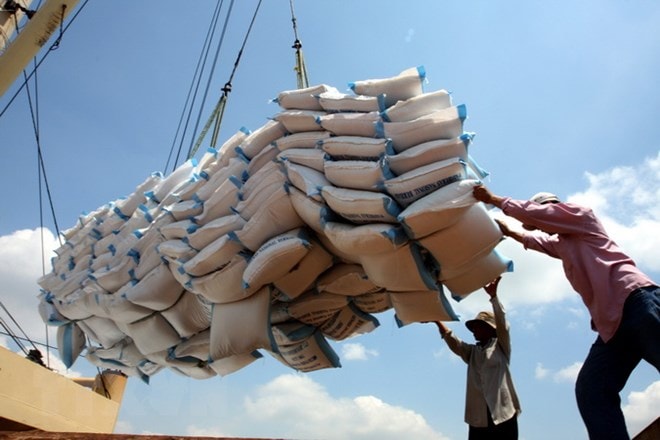The Ministry of Agriculture and Rural Development said: Vietnam's rice exports in the first 9 months of 2024 reached 4.37 billion USD, up 23.5% over the same period last year.

Recently, the Indian Government has lifted the ban on exporting non-Basmati white rice, ending more than a year of stopping sales abroad. Commenting on this move by India, Deputy Minister of Agriculture and Rural Development Phung Duc Tien said: The fluctuations in the Indian market in rice exports will have an impact on Vietnam's rice exports. However, Vietnam has built an ecosystem in the rice production value chain, so the impact will not be too great.
According to Deputy Minister Phung Duc Tien, this is not the first time India has lifted the ban on rice exports. Currently, Vietnam has a relatively stable market share, value, and quality of rice in the world market. With a relatively tight and systematic ecosystem in the value chain linked to the market, Vietnam will not be too affected.
The Ministry of Agriculture and Rural Development said: Vietnam's rice exports in the first 9 months of 2024 reached 4.37 billion USD, up 23.5% over the same period last year. Export output exceeded 7 million tons, up 9.2%. The average rice export price reached 624 USD/ton, up 13.1%.
India's decision comes as the country's rice harvest in 2024 is expected to be higher, bolstering state reserves to meet domestic demand and farmers preparing to harvest the new crop in the coming weeks. The return of rice from India has caused the rice market in countries such as Thailand and Vietnam to adjust prices slightly to compete last week, which has also cooled down rice prices in the global market.
According to the Vietnam Food Association (VFA), the price of 5% broken rice in Vietnam on October 3 was 539 USD/ton, down more than 20 USD compared to last week. Similarly, the price of rice in Thailand also decreased to about 550 USD/ton, the lowest level in more than a year, under pressure from sluggish demand and competition from cheaper rivals.
Vietnamese rice exporters say India’s return to the market will put downward pressure on prices of popular rice varieties such as 5% and 25% broken rice from Vietnam. However, Vietnamese rice prices are unlikely to fall below $500 per ton due to limited domestic supply.
According to Mr. Do Ha Nam, Vice President of the Vietnam Food Association, India's lifting of the ban on rice exports will not have much impact on domestic rice export prices. Because Indian rice varieties are different from those of Vietnam. Indian rice is mainly low-grade rice and exported to African markets. Meanwhile, in Vietnam, most of the acreage has been converted by farmers to grow high-quality rice varieties.
Recently, Vietnam won two bids for nearly 60,000 tons of rice in Indonesia’s September rice tender with a winning bid price of $548 per ton, down $32 from last week. Despite the price drop, demand from key markets such as the Philippines, Indonesia and Malaysia remains high, creating great pressure on demand for Vietnamese rice.
The Ministry of Agriculture and Rural Development said that, to date, the whole country has cultivated 6.93 million hectares, up 0.2% over the same period last year. Localities have harvested 5.4 million hectares, up 0.7%; the average yield is 6.3 tons/ha, up 0.5 tons/ha. The output on the harvested area is 34 million tons, up 1.5%.
The summer-autumn rice crop in the South is now entering its final stage. The autumn-winter rice crop in the Mekong Delta provinces has been planted on 626,000 hectares, an increase of 2.9%. However, the cultivated area for this rice crop is not large, so the rice output from now until the end of the year will not be too abundant.
Meanwhile, with high-quality rice, businesses believe that Vietnamese rice still maintains its competitive position in the world market. According to Mr. Dinh Ngoc Tam - Deputy General Director of Co May Company, the price of ST 25 rice will hardly decrease, and may even increase due to the scarcity of supply. Although world rice prices tend to decrease, thanks to high demand from large markets and high-quality rice varieties such as ST24, ST25 still maintains its position.
Even in the autumn-winter crop, localities have advised farmers to grow high-quality rice varieties, such as RVT, ST21 and ST25, for domestic consumption and to prepare for the upcoming Tet rice. The rest is sold to markets such as the Philippines, China, the Middle East and the EU.
From another perspective, in the past 9 months, Vietnam imported rice worth 996 million USD to serve domestic production and consumption needs, up 57.3% over the same period last year. This is a record high for the rice industry so far, and far exceeds the import turnover of 860 million USD for the whole year of 2023.
If the import rate is maintained as in the past two months, rice import turnover in 2024 could reach 1.3 billion USD.
According to experts, in recent years, Vietnamese farmers have strongly shifted to growing high-priced rice, while the amount of rice in the average and common segments has gradually decreased. In order to better adapt to climate change, many areas only produce one crop of high-quality rice, the rest of the time is spent raising shrimp and fish. To make vermicelli, pho, many types of processed rice products, or animal feed, etc., we need medium-sized rice. Therefore, in recent years, in addition to exporting, Vietnam has also imported a large amount of rice to fill the gap.
Statistics also show that the average export price of rice from Vietnam in the first 9 months of this year was 624 USD/ton, up 13.1% over the same period last year. Meanwhile, according to records from businesses, the price of imported rice to Vietnam is commonly around 480-500 USD/ton.